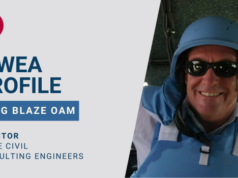Gary Losier is the leader of asset management for a small Canadian town and also President of the American Public Works Association, an organisation with more than 32,000 members. It has given him a unique perspective on how the big issues can be applied on a smaller scale, and how smaller town issues resonate on a more universal basis.
When Gary Losier led the introduction of GPS and Automated Vehicle Location Unit (AVL) technology in snowploughs in the Canadian city of Quispamsis a few years ago, he concedes there was pushback from some people in the organisation.
Quispamsis, a community of around 20,000 people on the Atlantic coast of Canada, was one of the first municipalities in the region to use the technology and at that time its benefits were not widely understood.

“We had a dozen trucks and in the first winter I think we saved around C$70,000 in salt that we didn’t have to put down, and we were able to show those savings,” says Losier.
“Then we were able to take that money we saved and buy a storage facility, a canvas dome, and then we were meeting environmental standards so we were looking good on two fronts.”
Losier has been the director of engineering and works for the Town of Quispamsis for more than three decades, and as the town has grown from a population of 3500 to 20,000 he has also seen a big change in the way public assets are managed.
Where assets were once managed largely in isolation, now there is a more integrated and holistic approach which factors in issues of financial and environmental sustainability and balances maintenance and replacement costs as part of a wider asset management plan.
“One of the biggest changes in Canada, and in our province of New Brunswick in particular, was the introduction of linked funding to our capital and infrastructure funding,” says Losier.
“So you had to provide an asset management plan or a financial plan if you wanted to get infrastructure funding for a water or a wastewater project or whatever there were minimum standards that you had to meet.”

Around this time, Losier did the IPWEA Professional Certificate in Asset Management Planning and Quispamsis also hired a consultant to develop a comprehensive asset management plan for the town.
“That was around a dozen or so years ago, and now when we talk to council about making a decision they ask how does it relate to our asset management plan,” he says.
One example is in pavement rating, a system which quantifies the performance of a pavement network and helps inform the management of maintenance and replacement.
“Having a plan and a framework has really taken the politics out of it,” says Losier.
“Once upon a time you’d get a call from someone complaining about their street, and because they were complaining and might be well known in the community you’d go out there and do something.
“Now, with pavement ratings we have a metric which tells us about the condition of the asset and helps us understand the cost of paving the street now compared with maintenance.”
In his role at the APWA, Losier brings the perspective that asset managers face similar issues around climate change, financial sustainability and challenges in professional development which span both the USA and Canada as they do big and small towns. APWA convenes a Global Big Cities/Counties group twice a year. It is there it is learned that small and large have the same issue just on different scales and we can learn from each other.

“I can be speaking with someone who is a public works director from the city of Los Angeles and they have a budget of US$500 million and I’m sitting on C$20 million,” he says.
“That sounds like an astronomical difference, but we start talking about HR issues and getting people into asset management and climate change and you understand that they have the same issues but on a larger scale.”
In some ways, Losier says he can be a little more “nimble” in his decision making in Quispamsis.
“We can say ok, we need to do this so we can turn on a dime and that makes us more adaptable, so there are benefits to being small,” he says.
As an advocate, Losier is about “having a seat at the table” and this means small organisations engaging with much larger peers, and the profession – through organisations like the APWA – engaging with infrastructure planners and governments to influence better outcomes for communities.
“I’m also the fourth Canadian to be President at the APWA, and the last one was 12 or 13 years ago,” he says.
“So I want to push that international aspect, and we have to recognise that we don’t operate in silos.
“We need to understand that perhaps the old way is not the best way of doing something, and that we should learn from each other and collaborate and improve together.”
Most of all Losier wants public works professionals to be proud of the work they do every day as first responders and as stewards of our infrastructure and be proud that we all have made commitments to our communities that improves quality of life for our residents and families.














